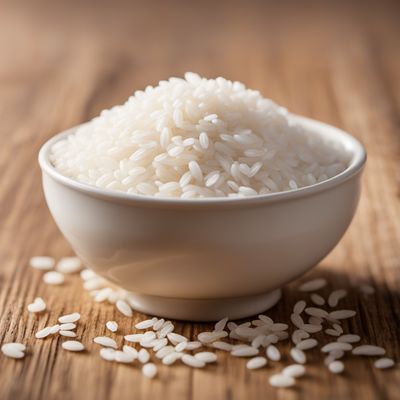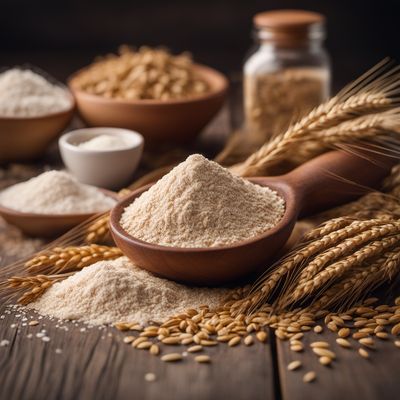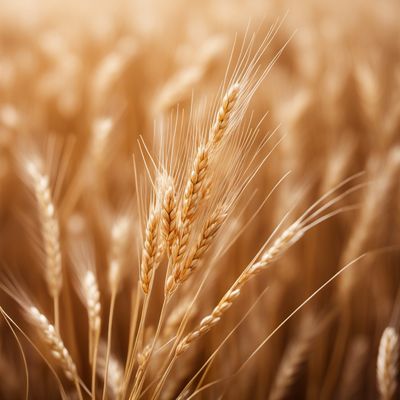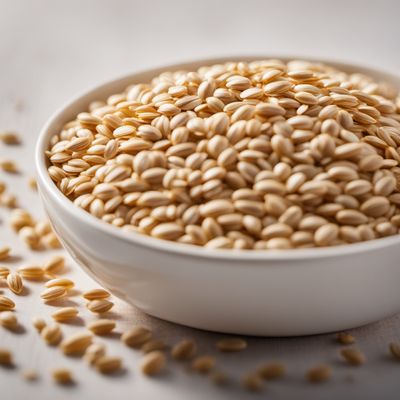
Ingredient
Cereal and cereal-like flours
The Versatile World of Grain-Based Flours
Cereal and cereal-like flours encompass a diverse array of ground grains and pseudo-grains, each with its own unique characteristics. Wheat flour, the most common variety, is prized for its versatility and ability to create light, fluffy baked goods. Cornmeal, with its coarse texture and distinct corn flavor, adds a delightful crunch to dishes like cornbread and tortillas. Other popular options include rice flour, which lends a delicate texture to gluten-free recipes, and oat flour, known for its nutty taste and ability to add moisture to baked goods. These flours vary in color, ranging from creamy white to golden yellow or even deep brown, and can be finely ground or more coarse, depending on the desired application.
Origins and history
The use of cereal flours dates back thousands of years, with wheat being one of the earliest cultivated grains in ancient civilizations such as Mesopotamia and Egypt. Corn, native to the Americas, has been a staple food for indigenous cultures for centuries. Rice, originating in Asia, has been cultivated for over 5,000 years. Oats have a long history in Europe, where they were commonly used for porridge and baking. These grains have played a significant role in the development of human civilization, providing sustenance and nourishment throughout history.
Nutritional information
Cereal and cereal-like flours are rich in carbohydrates, providing a good source of energy. They also contain varying amounts of protein, fiber, vitamins, and minerals depending on the specific grain. These flours can be a valuable source of nutrients such as iron, B vitamins, and dietary fiber.
Allergens
Wheat flour is a common allergen, particularly for individuals with gluten intolerance or celiac disease. It is important to note that some cereal-like flours, such as cornmeal or rice flour, are naturally gluten-free and can be suitable alternatives for those with gluten sensitivities.
How to select
When selecting cereal and cereal-like flours, it is important to consider the freshness and quality of the product. Look for flours that are well-sealed and free from any signs of moisture or insect damage. Check the expiration date to ensure freshness, and if possible, opt for organic or locally sourced flours for a higher quality product.
Storage recommendations
To maintain the freshness and quality of cereal and cereal-like flours, it is best to store them in airtight containers in a cool, dry place. This helps to prevent moisture absorption and the development of rancidity. It is also advisable to use the flours within a reasonable timeframe to ensure optimal flavor and texture.
How to produce
Growing cereal grains and producing flour on a small scale can be a complex process. However, for those interested in producing their own flour, it is possible to grow grains such as wheat, corn, or oats in a home garden or small plot of land. Once harvested, the grains can be dried and milled using a grain mill or other suitable equipment to produce homemade flour.
Preparation tips
Cereal and cereal-like flours can be used in a multitude of ways in the kitchen. They are commonly used as the base for bread, cakes, cookies, and pastries, providing structure and texture. These flours can also be used as thickeners in sauces, gravies, and soups. When working with gluten-containing flours like wheat, it is important to handle the dough gently to avoid overdeveloping the gluten, resulting in a tough texture. For gluten-free flours, it may be necessary to combine them with other ingredients or use binding agents to achieve the desired texture.
Substitutions
Suitable substitutes for cereal and cereal-like flours depend on the specific recipe and desired outcome. For gluten-free alternatives, almond flour, coconut flour, or a gluten-free flour blend can be used. In some cases, other grain flours like rye or spelt can be substituted for wheat flour, although the flavor and texture may differ slightly.
Culinary uses
Cereal and cereal-like flours are incredibly versatile and are used in a wide range of culinary applications. They are the foundation for baked goods such as bread, cakes, cookies, and pastries. These flours can also be used to make pasta, pancakes, waffles, and dumplings. Additionally, they can be used as thickeners in sauces, soups, and stews.
Availability
Cereal and cereal-like flours are widely available in grocery stores, supermarkets, and specialty food stores worldwide. They are commonly cultivated and processed in regions such as North America, Europe, Asia, and South America.
More ingredients from this category » Browse all

Rice flour
The Versatile Grain Powder

Flour mix (like wheat/rye/barley/oats and other)
Versatile Blend for Every Recipe

Wheat flour
The Versatile Grain: Exploring the Wonders of Wheat Flour

Barley flour
The Nutritional Powerhouse: Barley Flour

Spelt flour
The Ancient Grain of Spelt

Buckwheat flour
The Nutty Powerhouse: Buckwheat Flour

Cereal and cereal-like flours not separately listed
The Flour Power: Unleashing the Versatility of Cereal and Cereal-Like Flours

Sorghum flour
Sorghum Flour: A Nutritious and Gluten-Free Alternative

Oat flour
The Wholesome Power of Oat Flour

Maize, milled
Golden Grain: Unleashing the Power of Milled Maize

Amaranth flour
The Ancient Grain Flour with a Nutty Twist

Rye flour
Hearty Grain